Back in 2002 a bunch of guys on the streamers@ mailing list decided to tie some flies "in the hand" without the benefit of a vise. This year a new crop took up the challenge with a different fly - Carrie's Favorite - and tackled the Look Ma, No Vise challange.

Every once in a while some event in life comes up that causes you to slow down to consider your past. In the fall of 2009, I would have time on my hands to reconnect to my fly fishing beginnings - before I tied flies - before my mentor tied flies - and right into Upper Dam. We're talking about Carrie Stevens and big trout and salmon on streamer flies.
Trying to soak up every tidbit, I would discover on Raske's New England Streamer Page something called Carrie's Challenge. I approached Chris Del Plato about the idea of a Carrie's Challenge II which he presented to the Streamer List (defined as a group of fly tyers helplessly addicted to tying streamers). Thus new life was breathed into a decade old challenge.
Bryant Freeman and Chris would be the only two to take up the gauntlet a second time. The idea was to complete the project as a tribute to the fortieth anniversary of Carrie Stevens Day. Carrie's Favorite would be the fly to quickly become the focus of discussion on the correct pattern and the color "magenta." This fly was chosen because it is shows Carrie's use of color and the simplicity of a stunning fly to attract fish. Ted Patlen's words would ring so true that: "we're gonna see a wide variety of flies called 'Carrie's Favorite.'" How fitting to see first-hand the differences in color and style that certainly form regional variations in patterns over time.
The tyers for this round would span all skill levels from new to some well-known tyers who shared their thoughts through the process. The challenge reached across continents around the world. Twenty two folks started the challenge and the flies of those who finished are found here. The question isn't if there will be another challenge, but when. These folks "put up" and found some spots to reflect upon the trail to Upper Dam. Ken Craigue, Jr, Nov 2011
You have one shot to tie a Carrie's Favorite in hand, without a vise - just as Carrie Stevens herself did
The Challenge
Chris Del Plato (host): You have one shot to tie a Carrie's Favorite in hand, without a vise - just as Carrie Stevens herself did. You are allowed one try only. One shot, one fly. No practice, No 'do-overs', No
backtracking. No special tools should be used. Bodkin, Bobbin (for thread only) and scissors are the only tools allowed. Feel free to do without them, if you wish. If you must, a protective cup may be worn.
Please adhere to the original pattern as given here:
Any size is fine (size 2 would probably be typical), but about an 8x long shank would be true to form for a Carrie Stevens streamer. You may pre-assemble the wings (by hand), just as Carrie did. In fact, I would encourage this in the interest of being true to her methods. The use of glue in this process is also permitted, as there is evidence that she employed it. Please limit your use of glue to only the actual construction of the fly, especially if you are pregnant, or expect to become pregnant. Cramping, cursing, bleeding, spasms and fits of rage are all permitted, encouraged and expected. Crying is not allowed. There is no crying in fly tying.
Please document your trials and tribulations. A short paragraph describing your difficulties or what you learned by the experience is required. Please either private message your comments to me here or email to: cdelplato@gmail.com Do not use vulgarities in the subject line of your message, such as "To the #$@%&*! arse who dreamt up this torture", lest it be sucked up by my spam filter. Video documentary of your attempt would also be of interest and great humor to the group.
CD
All photos by Chris Del Plato, copyright 2011
ALAN PETRUCCI

This was a rewarding experience. The difficult parts of the construction were the tinsel body winding, the peacock herl tie-in and the head finish.
AL GROMBACHER

Tying it by hand was a challenge. It has been a while since I tyed with no vise. The hardest part was wrapping the body - it really wanted to unwind if I gave is any slack.
ANDY DOCHTERMAN

BOB FRANDSEN
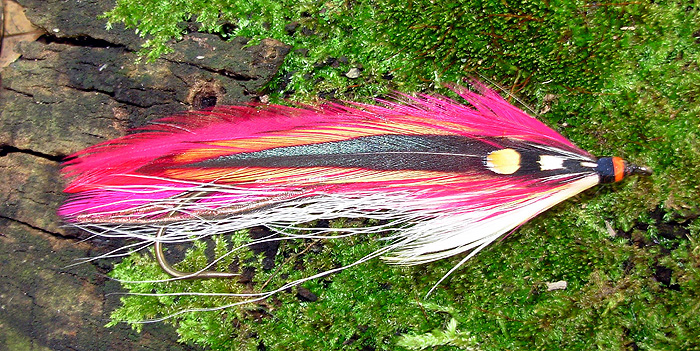
All I can say is... It's always a pleasure to be part of something like this . Perhaps even more so than some of you blokes on the spot being so far away from it all. Also the tying in hand part takes me back to when I first started tying as a youg'un of 13 when I couldn't afford a vise and had to do without. I don't think I'd care to go back to tying in hand on a permanent basis.
BRYANT FREEMAN

The challenge for me was to get time to do the tying of this fly for the Streamers Group. Just two weeks ago I received an order for 750 flies from a Salmon Lodge to be completed by June 1st. I finished the work on time, and then went on a trout fishing trip to the wilderness to get my head around the every day chores which were popping up. It is very trying when one spends all winter making flies at his leisure, then all hell breaks loose when the fishing season starts. Broken Rods, cracked lines, missing guides, and of course new purchases keep me busy for a month.
With this over on Friday, which was a nice sunny day, I decided to give er a go. I opted to hold the hook with my right hand because of an injury I incurred changing a reel from left hand wind to right hand wind, and the screwdriver slipped and went into my left index finger. Sugar (My Wife) a name from Sugar Babe fame in the Real McCoys TV Program in the 60's, did the bandaging job and made it a go for my tying to continue.
First I had to dye some Magenta Feathers then off to make the fly.
Here is the procedure and results of my Last attempt of tying without a vise.
https://www.salmonflies.com/carrieschallengeii.html
JOHN BONASERA

CHRIS DEL PLATO

As a veteran of the original Carrie Challenge back in 2001, I figured I had nothing to worry about with the redux. As things would go, however, I seemed to recall having less trouble with the Gray Ghost than this one.
Perhaps it was my tying rust, or the marathon of winding a full tinsel body. Regardless, I hand-cramped my way through it and half hitched to take a break between steps. A pretty pattern, although in hindsight I wish we had selected a pattern with a shoulder, both for the added visual appeal and extra challenge. All things considered, I was happy enough with my results.
DARREN MACEACHERN

It wasn't the first time I had tied a fly in hand, but it isn't something I do often. The first times I have tied in hand was because I had forgotten a vise to tie on when attending fly tying meetings with the Northern Lights in Edmonton, Alberta. Since the challenge, I've been tying the odd streamer in hand, just for a bit of practice and to give me some perspective on what the tyers of Carrie's period had to work with, and to gain some appreciation for our modern tools and vises. I must admit that I didn't struggle with
the process as much as I expected to, and that the gratuitous use of half hitches saved the streamer from totally unraveling at least once. I also made sure to have a clear space on a usually full (read messy) tying table and to have all the materials prepared before starting. The wing is prepared as always and set aside to dry. It's easy to see why Carrie tied in stages rather than tying one fly start to finish using her methods.
One of the challenges of tying in hand on the long hooks is to just to start the thread at the eye as i usually do. It took a bit of strange uncomfortable contortion with my fingers, but once the thread was jammed, things moved quickly. The hardest part of the fly was attaching the wing (challenging with or without the vise), which I managed by setting one side than the other. Once the wings were placed, I set them into position and then added the finishing wraps of thread. I found i wanted to "groom" the fly, but with my left hand occupied with the hook, I had to employ the right to play double duty. I tried to use as few tools as I could, and instead of using a vise, I used a length of thread with a pair of hackle pliers to help keep some weight on the hook. I usually tie with my scissors in hand but found that I needed to set them down so as not to fumble them into the nest of hook and thread.
One real benefit of tying in hand was that I could grasp the fly head the head after the body portion was completed. If you tie on a flimsy hook such as a Mustad 3907A or a 94720, this would really come in handy,
but less so on the stouter hooks.
GREG SALTZMAN

JAY SMIT
KEN CRAIGUE

I thought I was on easy street, until I tried to set and align the wings... Looking back, I heavily waxed silk thread which worked great because it was almost sticky and with a half hitch stayed put. I elected not to use a bobbin and have a new outlook on thread tension -- even tacky thread won't save you from the fly away if you let up at all. I am a south paw and found that I used both hands to alternately keep tension and pinching the thread to position materials. I did pre-assemble the wings, but early on I picked furnace saddles to sub for the golden badger that turned out a little too stiff and one went cockeyed during alignment. Getting the ring on the head would have made good humor on video as you may tell from it's unique curve.
For one, I can say that I am glad for my vise & tools. I hold our host's sentiments from the last challenge that while I won't be in a big hurry to do another, I too am glad for the connection it gave me to our streamer tying roots and a greater appreciation for just how talented Carrie Stevens was and the mark she made out of Upper Dam.
RENE ZILLMANN

Ok, my experience from tying the fly in the hand:
1. Holding the hook in the hand was not such a big deal, controlling the tension of the fingers/thumb was important.
2. Half hitch after applying new material and doing the wraps to secure it. Otherwise no chance to put it on the table to search for next material.
3. Necessary to prepare all materials in advance.
4. Wings have to be pre-assembled for this.
5. Tying a streamer is ok, but a sz. 18 dry?
6. And the desk must be very clean, usually my vise emerges out of the clutter of the tying table.
RICH CONNORS

It was fun tying a fly without the help of a vise for the first time. The hardest part was trying to keep from messing the fly up too much and keeping the material looking decent. I didn't feel it was too hard to tie it in hand but I think that had to do mostly with the pattern that was chosen. I think if it was a fly that had as many materials such as the Grey Ghost that it would have been more difficult. Nonetheless I'm glad I got the chance to participate and look forward to doing more flies without a vise from time to time.
ROYCE STEARNS

SCOTT BERNARD

The Carrie's Challenge II was definitely a learning experience for me. I knew going into it that after I was finished, I'd come away with something I didn't know. What surprised me was my preconceptions were completely off for the most part.
The hardest part I found was the body work. Between fighting keeping my fingers off the point of the hook and the paralyzing cramps from keeping tension on the thread, floss and ribbing I found myself begging for a
break and no way to tie off to take one. I kept thing Carrie probably did this after she'd washed 3 loads of laundry and had dough rising for the day's bread! My guess is that not having done this before, I had no
muscle memory for how mush pressure is needed to keep everything in place.
I basically was squeezing it too hard.
The wing mounting was where I learned the most in the challenge. I actually found it easier to mount the wing correctly in the Steven's style when they fly is in hand then when it's in a vise. The pre assembled wing she used makes much more sense this way as well. In hand, your about to press the 2nd side to the first better in one seamless unit. I think it's probably because the pressure applied with the fingers needs to hold everything.
You can also look straight down the hook shank as apposed to the side so you can see what you're doing. The only tricky part is keeping the hook straight but I got it on the first try and it came out pretty good.
The only catch is that I have no idea if the fly would hold up to fishing. I really only used the bobbin as weight on the thread so I don't know if the wraps are tight enough or not.
This was a fantastic exercise and I'd encourage anyone who hasn't tried it to do so. I'm sure you'll learn something. I'm not ready to give up my vise anytime soon.
TED PATLEN

Tying without a vise is a challenge to the muscles and fingers. getting the "vice" hands muscles to relax yet provide enough tension takes time. you gotta get thru the initial pain. but by using a well waxed thread
and many 1/2 hitches the fly can be put down.
Your fingers are in constant contact with the ribbing, floss etc and such manipulation gives the fly a special look. not the shiny glossy, showroom finish we see all the time with the macro-photography patterns
usually displayed...the fly looks real.
I think it's easier to do certain procedures such as applying tails, throats and wings , the body along the long shank was arguably the more daunting task.
After tying a few i believe you will see why stevens tyed her flies in that "special" style.
- The tail starts past the point where her fingers hold the hook.
- A very slim body using four strand silk and only one layer from back to front.
- The shortened body at the front where the bucktail, peacock, hackle and crests sit are not too far away from that holding point as well. (how large were her hands ...or better stated , how long were her fingers?)
- Wing components glued together and mounted on the top sides of the hook
All these operations are easiest and faster when done in hand especially the setting of the wings...as your hands are not articulated to the fixed angle of the vice...ease of tying means stronger flies faster and more efficiently... qualities a commercial tyer needed. okay?
- Log in to post comments

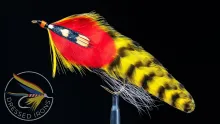
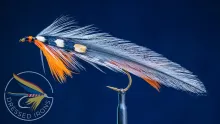
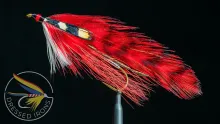


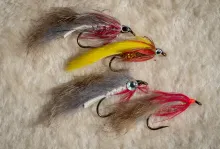

I AM IMPRESSED! Rea
I AM IMPRESSED! Really great work everyone that that took the CS Challenge II. Having been one of the ones inspired by the first challenge years ago and then to be driven to take up the torch of tying streamers the CS way and carry on the tradition sharing it with others I would reiterate- I am impressed. I first learned to tie the patterns well enough with a rotating vise then to take up the challenge of tying in my hands was not a terribly difficult task. I found that when I figured out how to keep the tension on the materials then all was well. Keep in mind that even CS said that no fly tyer would take up her methods if they were to commercially tie her patterns in that it was time consuming, but worth if it for quailty and durability. Hats off to all that took the challenge!
Nicely done.
Nicely done.
I have try to tie w
I have try to tie without a vise it didn't turn out well so you guys have my deepest resepect
Beautiful job by eve
Beautiful job by everyone! A Slight edge to Chris. I am jealous because i need a vise to tie. I have arthritis in both hands and sometimes can't straighten my fingers in the morning. At least that is my excuse. Kudos to all the brave guys that gave it a shot.
Joel
Truely flytying art
Truely flytying art at it's finest,forgotten how beautiful these old style streamers can be,use to tye Gray ghost,& Pink Ghost for a gentleman,who has since passed on,boy do I miss tying for him,keep up the good articles,tight lines,friends.